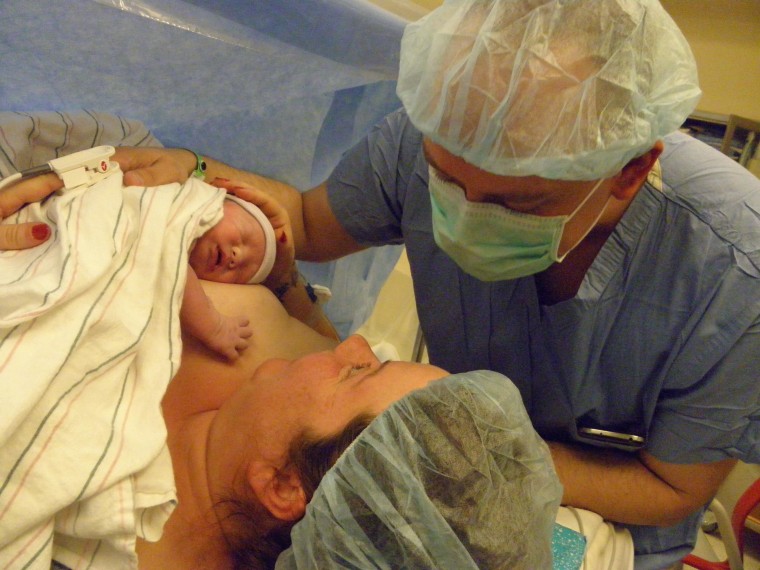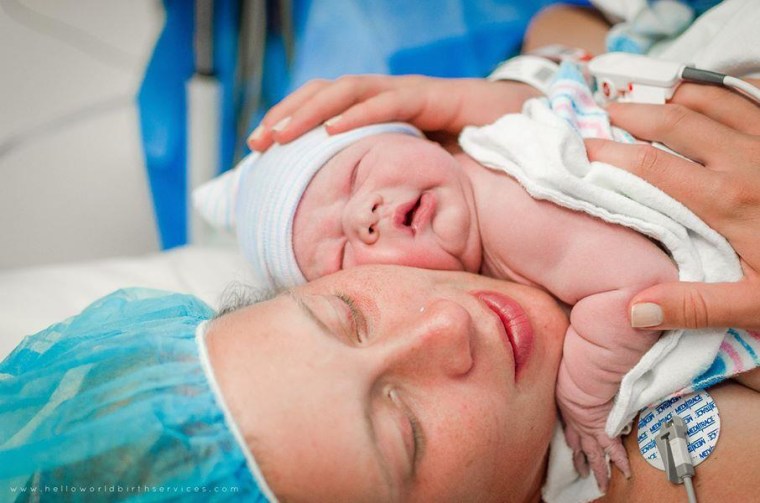For all the joy of expecting her first baby, Monique Reese’s heart sank when she found out she would have to deliver via a cesarean section last fall.
Friends and family who had gone through it told her it was more like having surgery than giving birth. A C-section is just happening to you, it’s not an experience, they complained.
“Nobody had anything positive to say about it,” Reese, who lives in Boxford, Massachusetts, told TODAY Parents. “(But) it just couldn’t have gone any better than it did... it was just very lovely.”

Reese, 37, chose what's called a "family-centered" or "gentle" cesarean section at Brigham & Women's Hospital in Boston, one of a growing number of U.S. hospitals offering this option. The new approach mimics some of the essential elements of natural childbirth, like letting parents watch the baby emerge and allowing them to hold the baby right away.
Advocates say it’s about time: One third of the almost 4 million babies born in the U.S. each year are delivered via C-section, but many women find the experience traumatic.
“Cesarean births can… leave you feeling like you are a failure. I spent many moments mourning and feeling empty after my surgical birth,” said Kristin Severson, a photographer in Wausau, Wisconsin. Now pregnant with her third child, Severson is hoping to be cleared for a vaginal birth, but is comforted by having access to a family-centered cesarean if not, she said.
Dr. William Camann, director of obstetric anesthesiology at Brigham & Women's, began implementing the family centered approach — which the hospital calls “the gentle cesarean” -- in 2013.
“Childbirth is such a natural event, but so much of it has become medicalized,” Camann said.
“To try to get a little bit of humanistic touch back into this very medicalized procedure is just such a good thing for patients.”

The new approach is just a slight modification of the way doctors have always performed C-sections, Camann said. Blue surgical drapes are still set up to provide a sterile environment, but parents can ask for a clear drape just before the baby emerges so they can watch him or her being born.
“It was a pivotal moment… it was what I had been waiting for the whole nine months,” Reese said about her first glimpse of her son Brevyn.
The big focus is allowing skin-to-skin contact between mom and baby, which is routine after vaginal deliveries, but harder to accomplish with C-sections and a patient hooked up to a maze of monitors.
To make it possible, the EKG electrodes that watch over mom's heart are placed more towards her back and side to leave room for the baby on her chest, Camann said.
The blood pressure cuff and other monitors are placed on one arm, so she has the other arm free to hold the baby. Once the pediatrician checks out the newborn, the little one can be on mom’s skin immediately or within minutes rather than being whisked away, he noted.
“I wanted to be able to see him, touch him and hold him. I wanted him to feel safe and warm,” said Bobbi Jo Fischer of Wausau, Wisconsin, who had a family-centered C-section when she delivered her son Ezekiel at Aspirus Wausau Hospital in 2013.
“It was so healing in so many ways. I felt in control of my body and my birth even though so much was out of my control.”
She could nurse, bond and snuggle, and though she has not had a vaginal birth, Fischer felt this was as close as she could have ever gotten — her elation captured in a beautiful photo taken by Severson.
With the family-centered C-section, women can sometimes breastfeed in the operating room. Dads can also experience skin-to-skin contact with the baby, like Reese’s husband did.
“It requires (doctors and nurses) to just think a little bit differently than the way they have usually done things,” Camann said. “Once they see this, they usually realize it’s really not that difficult.”
He estimated the family-centered approach makes up about 20 to 30 percent of all C-sections at Brigham & Women's Hospital. Nationwide, dozens or perhaps hundreds of hospitals are offering the option, Camann said. One mom has even started a movement to encourage all hospitals to implement it.
The procedure is not recommended for women with preterm births, those having emergency C-sections or delivering a baby who is at risk for a low Apgar score.
Camann also emphasized it's not in any way meant to promote more C-sections.
“We would all like to do fewer C-sections. But there are women who need a C-section for various medical reasons and if you do need a cesarean, we want to make this a better experience,” he said.